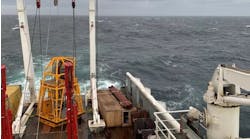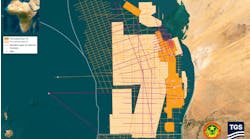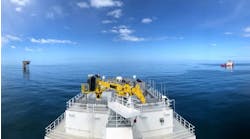Gene Kliewer • Houston
The reprocessing of 7,357 km (4,571 mi) of 2D marine seismic data acquired in the 1980s off southeast Greenland is done, according to Spectrum and Petroleum Geo-Services.
Using techniques perfected for sub-basalt imaging in the UK Atlantic margin and offshore India West Coast, Spectrum and PGS improved definition of the pre-Tertiary basalt sedimentary section. This reprocessed seismic data is now available as a final pre-stack time migrated product from either company.
The data is from between 62º and 7º latitude and includes the southern part of the East Greenland rift basin. A 2007 US Geological Survey assessment of the data indicated undiscovered oil and gas reserves of 31.4 Bboe.
The report says East Greenland forms the conjugate margin to the Norwegian continental shelf, Faroe-Shetland Islands, and Rockall basins. Interpreters expect analogues of successful plays in these better explored petroleum provinces will extrapolate into eastern Greenland.
In a separate action, Spectrum has released a new suite of products called “East Med 2011.” The release covers more than 22,000 km (13,670 mi) of 2D multi-client seismic data, a well data report, a detailed analysis of geology offshore Lebanon, a Lebanese country guide, and training in deepwater exploration of the eastern Mediterranean.
Spectrum developed these products following Noble Energy’s drilling success at Dalit, Tamar, and Leviathan in the Leviathan basin. The well data in the suite includes data compiled on detailed stratigraphy (biostratigraphy and lithostratigraphy), well logs, pressure tests, and drilling results from nine wells in the region.
Compiled recently by ATenergy, the report gives detailed interpretation of regional geology and tectonics. It also contains seismically derived maps of offshore Lebanon and analysis of the recent Noble discoveries.
Deepwater seismic node development
PGS also has agreed to cooperate with SeaBird Exploration Plc to move forward the development of ocean bottom nodes for use in deepwater.
“This agreement enables the two companies to provide a complete seismic offering in deep water areas, in areas with complex geology, and in areas with heavy infrastructure on the sea bottom,” said Jon Erik Reinhardsen, CEO of PGS.
PGS says expects this agreement to be of benefit also in the reservoir monitoring market, which has been, and is expected to be, the fastest growing segment of the seismic market.
New technology releases
Sercel has released an enhanced version of TriggerFish, its real-time navigation and data acquisition system for control of a distributed fleet of vessels during acquisition in transition zone, OBC, node, and 2D streamer seismic surveys.
TriggerFish 1.7 features multi-shooter/multi-recorder, and advanced radio communications and fleet synchronization. The system can scale to four vessels per radio link. Additional features are provided through enhanced mapping functionality which includes the zone incursion and proximity alarm system.
TriggerFish 1.7 also has operational advantages, according to Sercel. The need for fewer operators reduces the cost of operations and longer radio network ranges enable more advanced survey designs using larger seabed receiver patterns, longer streamers, and longer wide-azimuth offsets.
Fugro-Jason has released a new version of its petrophysical interpretation software. PowerLog 3.2 adds new features and enhances many current capabilities.
New features include an electrofacies interpretation module based on interactive selection of curve values on logplots and crossplots, sample highlighting across viewers (logplots, crossplots, histograms) to identify data of interest and to output a curve with different values assigned to samples in the different highlight sets, interactive core shifts with concurrent construction of core shift tables that can be applied to other cored intervals, and enhancements to all Logplot interactive editors (depth shift, baseline shift, etc.) to streamline editing.
In addition to the new features and enhancements, the new version further streamlines the user workflow within and across projects, says Fugro-Jason.
Geomodeling Technology Corp. has released SBED 4.1 and SBED 4.1 for Petrel. These near-wellbore modeling applications add automatic core plug conditioning to the modeling of small-scale sedimentary details and generates lamina-scale properties for use in reservoir modeling and simulation. This release also directly imports data from Numerical Rocks e-Core digital pore-scale modeling software. Additional new features include an improved simulation engine and data analysis tools.
Geologists and petrophysicists using SBED 4.1 can input core plug data derived from laboratory analysis and the application automatically conditions a near wellbore model to match those results, says Geomodeling.
“Core plug conditioning and a pore-to-lamina scale workflow are part of our focus on solving difficult problems that our customers face in today’s complex reservoir environments,” says Mark Klingbeil, Geomodeling CEO.
2011 Seismic Vessel Survey
Starting on page 38 is this year’s Seismic Vessel Survey. Based on the increased count, seismic survey companies are more optimistic than in the last couple of years. Check the table of vessels to see who can do what and where in the seismic acquisition business.
Offshore relies on the vessel owners and operators for this information. If you have any additional information, please send it to [email protected] at any time.
More Offshore Issue Articles
Offshore Articles Archives
View Oil and Gas Articles on PennEnergy.com




